GitHub Featured Views
Learning GitHub's Featured Views: Gain Insights and Enhance Collaboration with Issues, Commits, Pull Requests, Kanban Board, and Commit Activity Views
Features Available in GitHub Featured Views
| Function | Description |
|---|---|
| Issues View | Leverage the Issues View in GitHub to efficiently track and manage project tasks, bugs, and feature requests. |
| Commits View | Explore the Commits View in GitHub to gain a comprehensive overview of code changes, commit history, and associated details. |
| Pull Requests View | Utilize the Pull Requests View in GitHub to streamline the code review process. |
| Kanban Board View | Optimize project management with the Kanban Board View in GitHub, visualizing Issues, Pull Requests and their workflow status. |
| Commit Activity View | Analyze the Commit Activity View in GitHub to understand code development patterns, trends, and contributions. |
Issues View
The Issues View displays a list of all the issues in the repository sorted by most recently created.
To navigate to the Issues View select Issues from the left sidebar.

Add New Issues
To add new issues select the New Issue button at the top left of the Issues View.
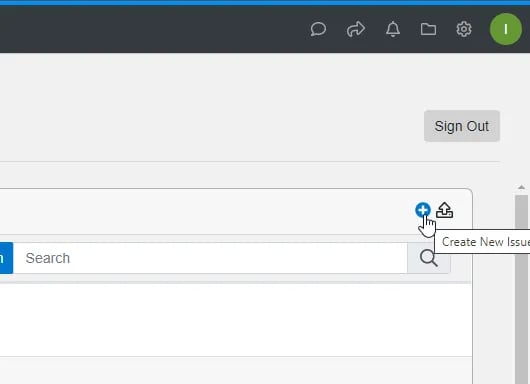
This will open the Create New Issue modal. There are inputs to add a title and description.

To add labels or assignees select the Labels or Assignees links to the right of the input boxes.
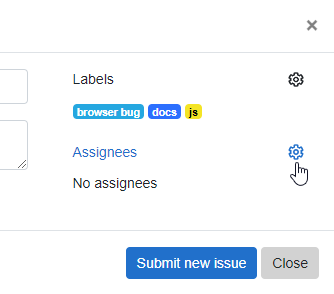
Once the dropdown is open select labels or assignees from the drop downs.

Once finished, select the Submit new issue button to finally submit the issue.

Edit Existing Issues
Select an issue from the list of issues.

A modal displaying the issue’s details will be opened. Any edits made in this modal will be automatically saved and updated in GitHub.
Here you can add comments by typing in the input box and selecting the Comment button when you are ready to publish your comments

In order to add/remove labels or assignees select the Labels or Assignees links on the right to open the dropdowns.

Once the dropdown is open, select a label to add. If the label is already selected it will have a checkmark. Selecting a label that is already selected will remove it from the list and therefore remove it from the issue.
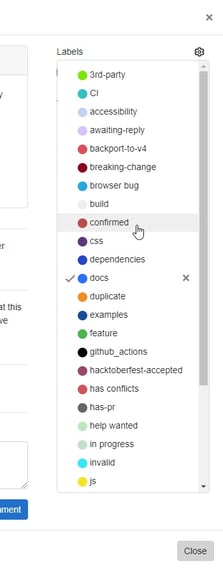
The Assignees dropdown works exactly the same as the Labels dropdown. Select Assignees to open the dropdown. Once the Assignees dropdown is open select an assignee to add or remove them from the issue.
Search Existing Issues
Using the search bar, at the top of the list of issues in Issues View, users can search for issues by name.

To clear the search bar select the X button on the right side of the search bar.
Filter Existing Issues
Filtering issues allows the user to filter issues by authors and labels. Users can also sort issues with the sort dropdown.

To select a filter or sort order select the Authors, Labels, or Sort dropdown link to the top right of the list of issues.
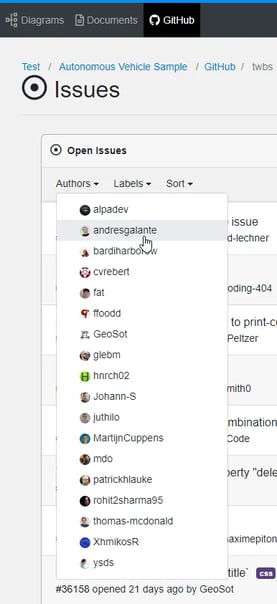
Select an option from the dropdown and the list of issues will begin filtering.
Commits View
The Commits View displays a list of all the commits in the repository sorted by most recently created.
To navigate to the Commits View select Commits from the left sidebar.
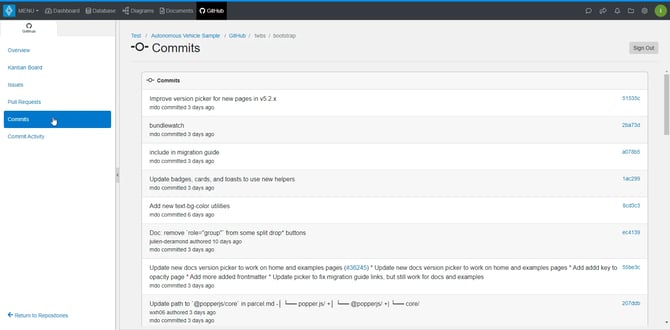
Commits have two types of clickable links. The issue number is a unique integer ID given to an issue or a pull request when they are created. Clicking an issue number in the commit message will open a new tab in GitHub and allow you to see the issue or pull request associated (assuming you have permission to the repository containing the issue or pull request).

The SHA (or “hash”) is a 40-character unique ID created by GitHub for every commit. Clicking the SHA in a commit will open a new tab in GitHub and display the changes made in this commit.

Pull Requests View
The Pull Requests View displays a list of all the pull requests in the repository sorted by most recently created.
To navigate to the Pull Requests View select Pull Requests from the left sidebar.
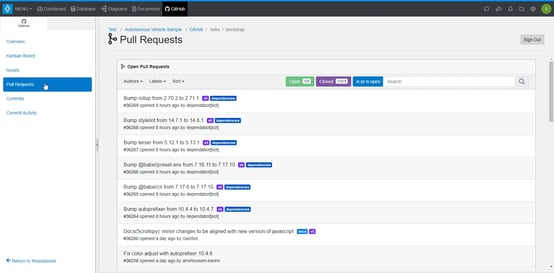
Edit Existing Pull Requests
Select a pull request from the list of pull requests.

A modal displaying the pull request details will be opened. Any edits made in this modal will be automatically saved and updated in GitHub.
Here you can add comments by typing in the input box and selecting the Comment button when you are ready to publish your comments.

In order to add/remove labels, assignees, or reviewers select the Labels, Assignees, Reviewers links on the right to open the dropdowns.
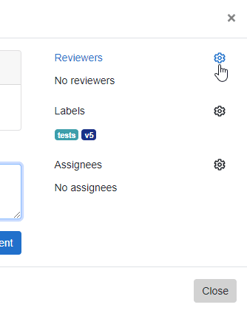
Once the dropdown is open, select a label to add. If the label is already selected it will have a checkmark. Selecting a label that is already selected will remove it from the list and therefore remove it from the issue.

The Assignees and Reviewers dropdowns work exactly the same as the Labels dropdown.
Select Assignees or Reviewers to open the dropdown. Once the dropdown is open select an assignee or reviewer to add or remove them from the pull request.
Search Existing Pull Requests
Using the search bar, at the top of the list of issues in Issues View, users can search for issues by name.

To clear the search bar select the X button on the right side of the search bar.
Filter Existing Pull Requests
Filtering issues allows the user to filter issues by authors and labels. Users can also sort issues with the sort dropdown.

To select a filter or sort order select the Authors, Labels, or Sort dropdown link to the top right of the list of issues.
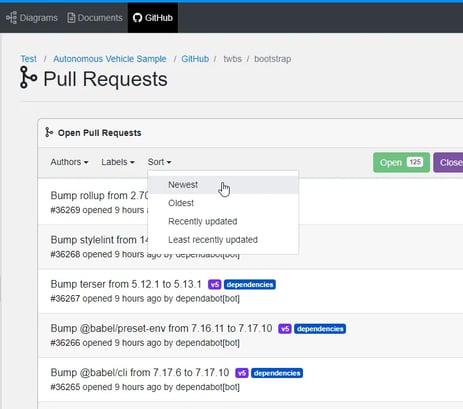
Select an option from the dropdown and the list of issues will begin filtering.
Kanban Board View
The Kanban Board View displays the Issues and Pull Requests of the Github repository.
To navigate to the Kanban Board, select ‘Kanban Board’ from the left sidebar.

Issues and Pull Requests are automatically sorted into 1 of the 4 columns:
- ‘Backlog’ contains issues where their most recent activity was more than 30 days ago.
- ‘Recent Activity’ holds issues that have had activity within the last 30 days.
- ‘In Review’ holds open pull requests.
- ‘Done’ bin holds issues closed within the last 30 days.
Editing Issues in Kanban View
Select an issue from any of the Kanban bins.

A modal displaying the issue’s details will be opened. Any edits made in this modal will be automatically saved and updated in GitHub.
Here you can add comments by typing in the input box and selecting the Comment button when you are ready to publish your comments.

In order to add/remove labels or assignees select the ‘Labels’ or ‘Assignees’ links on the right to open the dropdowns.

Once the dropdown is open, select a label to add. If the label is already selected, it will have a checkmark next to it. Selecting a label that has already been selected will remove it from the list and thus remove it from the issue.

The Assignees dropdown works exactly the same as the Labels dropdown. Select ‘Assignees’ to open the dropdown. Once the Assignees dropdown is open, select an assignee to add or remove them from the issue.
Commit Activity View
The Commit Activity View displays charts of each contributor’s commit activity over the past 6 months. The commit activity charts are ordered from most commits to least commits.
To navigate to the Commit Activity View select Commit Activity from the left sidebar.

You can filter dates by clicking the “Filter Dates” button.

Then, select a start date and an end date. Commit activity data is computed from week to week. This means that the available dates to select will always be the beginning of the week.
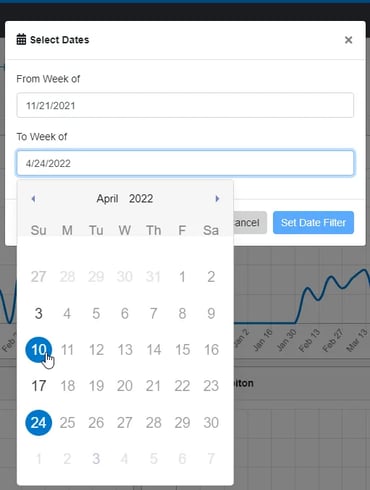
To continue learning about GitHub View, Click Here.
(Next Article: GitHub User Access)
